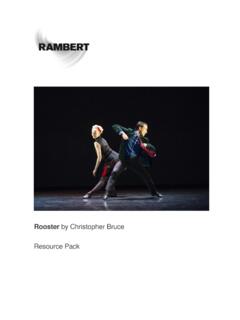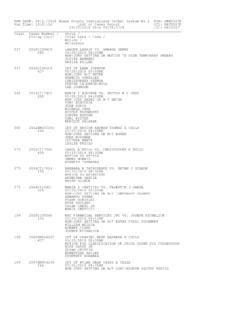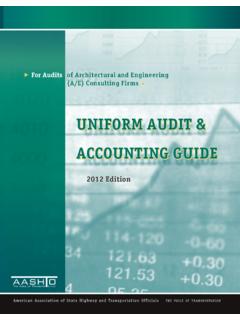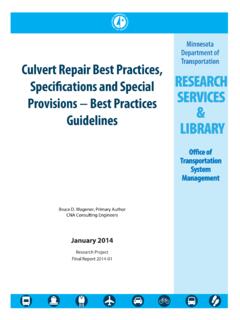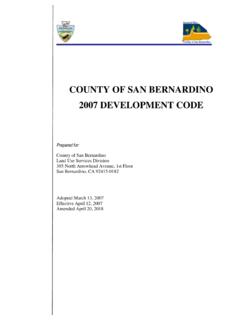Transcription of Ghost Dances by Christopher Bruce Teachers Notes
1 Ghost Dances by Christopher Bruce Teachers Notes Rambert Ghost Dances Teachers Notes p2 These Notes were compiled and written in 2000 and have not been rewritten for the new specifications for exams in AS and A level Dance from 2017 onwards, although it is hoped that these Notes will be a starting point for further work. Some of the material was adapted or reproduced form earlier resource packs. We would like to thank Christopher Bruce CBE (choreographer) and Michele Braban (choreologoist) for their help in compiling this resource. Practical workshops with Rambert are available in schools or at Rambert s studios. To book, call 020 8630 0615 or email This material is available for use by students and Teachers of UK educational establishments, free of charge. This includes downloading and copying of material. All other rights reserved.
2 For full details see Rambert Ghost Dances Teachers Notes p3 Contents Section 1: General Information page 4 Characteristic elements of Bruce s choreography in Ghost Dances Christopher Bruce on Ghost Dances Synopsis of Ghost Dances Music and Design information Section Two: Appreciating Ghost Dances page 10 Critical responses to Ghost Dances in performance Section 3: Practical Work page 12 Workshop 1: Ghost Dancers Workshop 2: Red Dress Duet Workshop 3: The Dead Workshop 4: Manipulation: The Ghost Dancers and the Dead Glossary of terms page 18 Bibliography page 20 These Teachers Notes are intended as a companion to the Ghost Dances Study Notes , which contain detailed background information on Ghost Dances and are also available. Ghost Dances is Christopher Bruce s highly acclaimed work that is very popular as a study piece for both AS and A Level Dance.
3 Some of the material will be more appropriate for Teachers of these courses, but it is hoped that these Notes will be a starting point for further work. Rambert Ghost Dances Teachers Notes p4 SECTION 1 General Information Ghost Dances was choreographed by Christopher Bruce in 1981 for Ballet Rambert (as Rambert Dance Company was then known). Music South American Folk Music arranged by Nicholas Mojsiejenko from recordings by Inti-Illomani. (Ojos Azules, Huaja, Dolencias, Papel de Plata, Mis Llamitas, Sicuriadas) Set Design Christopher Bruce Costume Design Belinda Scarlett Lighting Design Nick Chelton Ghost Dances lasts approximately 30 minutes and has a cast of 11 Dancers (5 women and 6 men) Characteristic elements of Christopher Bruce s choreography in Ghost Dances Bruce prefers an audience to keep an open mind about his works, often avoiding programme Notes and specific statements.
4 However, he does recognise that his pieces are concerned with ideas, rather than abstract dance and there is usually strong imagery. The theme of Ghost Dances deals with political oppression and dictatorship in South America and Bruce s choreography reflects this in an eloquent and moving way. Several of Bruce s works express his political, social and ecological awareness. These include for these who die as cattle (1972) and Land (1985), evoking the horrors of war; Silence is the end of our Song (1983) and Swansong, concerned with political oppression; and Nature Dances (1992) and Stream (1996) concerned with the natural world. Bruce sympathised for those suffering as a result of the military coup in Chile and influences for the creation of Ghost Dances include The Chilean Human Rights Committee asking Bruce to create a work for them and Victor An Unfinished Song by Joan Jara.
5 His Dances generally develop from a stimulus such as music, painting or literature, but he selects themes that can be conveyed through dance, drawing from and abstracting his subject, rather than making direct reference to the original. For the creation of Ghost Dances Bruce researched the rituals and cultures of South America. The music of the Chilean folk group Inti-Illimani was influential to the creation of Ghost Dances . Bruce chooses a wide range of music, form popular songs (Rooster, to songs by the Rolling Stones), world music (Sergeant Early s Dream, to English, Irish and American music), classical music (Symphony in Three Movements, 1989, to Stravinsky), contemporary music (Meeting Point, 1995 to Michael Nyman and Four Scenes, 1998 to music by Dave Heath) to specifically commissioned scores in close collaboration with the composers (Stream; Philip Chambon and Rambert Ghost Dances Teachers Notes p5 Cruel Garden; Carlos Miranda).
6 The dance often responds closely to the music. Ghost Dances uses two songs and four folk tunes representing South American music. The design is an extremely important contributing factor to the whole, but Bruce is concerned that any stage setting does not intrude in to the dance area and that costumes allow for freedom for movement. He works closely with designers and sometimes creates his own designs. Lighting is always a significant element in the design for his works. For Ghost Dances Bruce designed his own set, with the costumes by Belinda Scarlett and lighting by Nick Chelton. Bruce always uses a blend of dance techniques, notably ballet and contemporary. His own contemporary training was in Martha Graham technique and strong use of the back and a low centre of gravity are important elements in his choreography. In addition, dependent on the work he is researching, he uses another technique, for example, incorporating a folk element in Sergeant Early s Dream, tap sequences in Swansong or the flamenco used in Cruel Garden.
7 He aims to give an essence of these styles, rather than reproducing them authentically. The choreographic vocabulary of Ghost Dances relies on ballet and contemporary techniques and incorporates elements of folk and social dance. He sometimes uses recognisable everyday movements, such as gesture incorporated into the choreography, notably in Rooster. The use of gesture in Ghost Dances is naturalistic movements that suggest sorrow. His works have a clear thematic base, even if they are non-narrative. He frequently demonstrates a strong sense of character; for example in Rooster, Swansong and Cruel Garden. The characters in Ghost Dances comprise of three Ghost Dancers and eight Dead (five women and three men). The Ghost Dancers have a strong presence and what they represent can be left to the individual to interpret. The Dead represent different social backgrounds and have individual characters.
8 Rambert Ghost Dances Teachers Notes p6 Christopher Bruce on Ghost Dances Some friends came out of the blue and said: Have you ever thought of using this music? The more I listened to it, the more I fell in love with it. They re very simple tunes, very often melancholy and deeply evocative. And about this time, I became interested in South America, especially the political situations and upheavals. Latin America seemed to me a little bit like ireland ; it had suffered terrible disruption and pain over hundreds of years since the Europeans began to sort of hit the continent. Although it has a South American setting, it s a universal story. You could parallel it with Poland or Afghanistan: cruelty, lack of human rights, people who suffer. So in a sense, it s indirectly political, but its very much about humanity and just about how people get caught up, suffer and die.
9 I discovered in some books on masks some wonderful old skull masks that the dancers wore when they celebrated death rites. And so, I created three giant condors. And although they re quite frightening in their masks, they are for me quite objective spirits; they just symbolise death. You can see them as a brutal force, but then death is often brutal. When death comes, they just take the people. In Ghost Dances , I bring what I call the dead , this little group of people into a place that s like a sort of stopping-off place, a resting place before they carried on into the Underworld. And as they pause in this place, they remember certain moments from their lives happy, sad or frightening which are always quite brutally broken up or stopped. And by the end, you ve knocked these people down, down, again and again, but they always proudly rise up and carry on.
10 There is a kind of dignity to the way they finally pass on to where they are going. And the Ghost dancers, the spirits who are always waiting in this lonely place, take up their position again to wait for the next group, because, you know, this is a continuing In a sense, my ballets have a narrative quality or some kind of subject matter. However, it s often not a specific one-line narrative, but a layer of images which form a kind a collage and leave room for the audience s imagination to work. Christopher Bruce interviewed by Carl Cunningham Parting Dances Houston Post, 22 May 1988 The Ghost Dances were part of Indian culture, both North and South America. They celebrated death and they wore wonderful masks. The Ghosts that come on to the stage are the Dead on their way to heaven or hell. I just saw it happening in a sort of rocky, barren landscape, where the Ghost Dancers had hung around for millions of years, lying on rocks like animal images.

